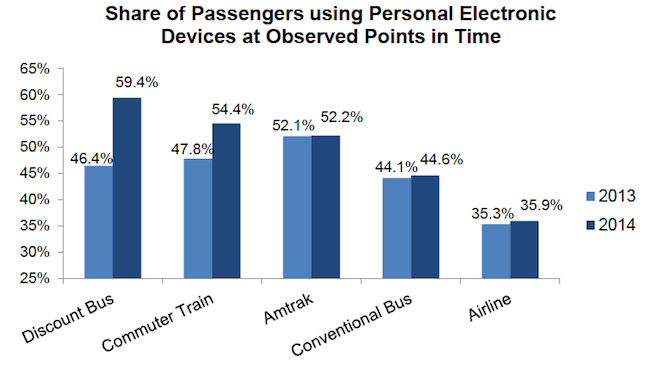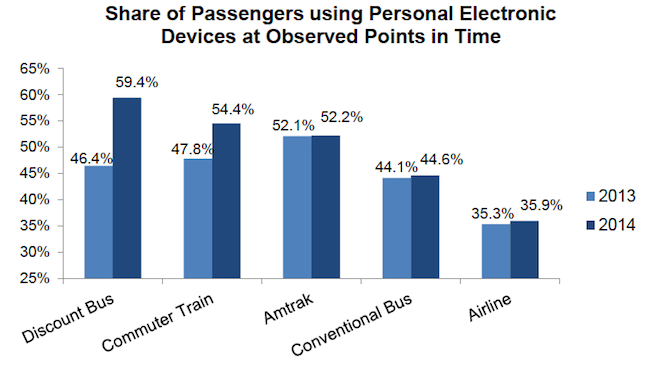Skift Take
Intercity bus service in the U.S. is not only a nice alternative for budget-concscious travelers, but Wi-Fi and other tech features can make for a very connected and productive ride.
Intercity bus services such as Megabus are driving their way straight to the top of the leaderboard when it comes to passenger technology use, according to a DePaul University study that examines the increased use of personal electronic devices among passengers on intercity buses, planes and trains.
Since last year, passenger technology usage has increased by 13 percentage points to 59.4% on discount and intercity bus lines, such as Megabus, Boltbus, DC2NY, and others the study found.
That growth pace for device usage on intercity buses far outpaced other modes of transportation, including airlines, where personal device usage was relatively flat at 35.9%, the study found.
Source: DePaul University
Technology use on the 20 commercial U.S. domestic flights studied “remained virtually flat and continues to lag behind other modes, suggesting that the relaxation of the FAA policy on the use of personal electronic devices is having little effect,” the study states.
Megabus provides power outlets at every seat and free Wi-Fi on most buses, features that still aren’t ubiquitous across conventional bus lines, airlines or trains.
The study, The Personal Tech Tidal Wave: The Rising Use of Electronic Devices on Intercity Buses, Trains & Planes, found that personal technology usage on commuter trains in the Chicago area jumped 6.6 percentage points 54.4 percent in 2014 while usage on Amtrak trains remained at roughly 52%.
The rise in device usage on buses can be attributed to the many tech-friendly conveniences they offer passengers while many airlines have been relatively slow in their rollouts of Wi-Fi and other features such as power outlets.
For most airlines there is no Wi-Fi service available for about 40 minutes of every flight during takeoffs and landings.
With buses and trains, passengers are free to use their devices uninterrupted from the time they get to their seat to when they arrive at their destination.
Megabus’ technology growth is also due to stronger cellular signals that are generally available along the highway routes they cover, combined with a younger student demographic of “digital natives” who take advantage of the bus line’s cheap fares.
Amtrak introduced Wi-Fi to it’s Midwestern corridor routes in February, which fits nicely with its spacious seating and tray tables, allowing passengers plenty of room to spread out and use their electronic devices.
Tablets and e-readers were more common on airplanes, accounting for one-third of device usage, the study found, while bus passengers used other devices such as smartphones most frequently.
The study covered 108 weekday departures from February 15 to June 15, 2014, on domestic commercial flights, Amtrak trains, conventional intercity buses (Greyhound), curbside bus departures (Megabus/Coach USA), and commuter trains in the Chicago area. Members of the study team roamed the aisles and recorded the activity of passengers using their electronic devices.
The Daily Newsletter
Our daily coverage of the global travel industry. Written by editors and analysts from across Skift’s brands.
Have a confidential tip for Skift? Get in touch
Photo credit: Intercity bus services such as Megabus are the fastest-growing transportation mode in terms of the percentage of passengers using personal electronic devices, Pictures, people wait to board a Megabus on South Canal Street in Chicago, Illinois,August 27, 2012. Terrence Antonio James / Chicago Tribune/MCT)

